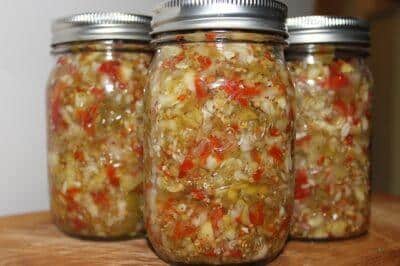
There are a lot of misconceptions out there about canning safety. As is true with many topics, information found on the Internet supports a wide variety of truths and opinions, and it can be hard to differentiate between them.
Canning safety is a big deal. Doing it right is what comes between eating home-preserved food with confidence and risking upset stomachs, spoiled and wasted food, serious illness, or in very rare cases even death.
Before I explain which techniques are considered safe according to modern-day science and which are not, let me address the inevitable questions. I hear them at every workshop I conduct and see it in every comment thread on forum discussions and social media.
“My grandmother used wax on her jams and all us kids grew up eating them.”
“The ladies at church just flip the hot chow-chow jars upside down and call it good.”
“My mother never owned a pressure canner and we all ate her canned beans and beef just fine.”
“We eat canned cake at camp every summer… and nobody ever died.”
New ‘Miracle Oil Maker’ Lets You Make Fresh Nut Oils Within Minutes!
And my answer is always the same. Sure. Each one of us knew of someone consuming food canned by what is considered today to be unsafe practices, and many of us did it ourselves. And we did indeed all live to tell the tale.
But why take the risk? People survived automobile travel before seat belts came along, but most of us wear them nowadays. Communities have thrived for centuries without modern-day sanitation and plumbing, but most of us today consider running water and flush toilets to be good things. Mammograms, steel-toed work boots, prenatal ultrasounds, child safety locks—all things people lived without, until the advantages of using them became clear.
You can take the chance of doing it the old-fashioned way if you want to, but know that it is a risk. No home-canning method is guaranteed 100 percent bulletproof, but using techniques tested and approved by science and research are the best ways to minimize potential problems.
There are three main points I would like to highlight – three things our grandmothers often didn’t do when canning. First, processing in a canner is necessary for every canned product. No shortcuts, no alternatives. And second, using a pressure canner is essential for all low-acid foods. Third, all recipes are not created equal. Read on for details.
1. Processing is crucial.
Old-fashioned methods and trendy hacks are not good choices. Topping preserves with hot wax allows potential harmful bacteria and molds to seep in. Even after mold is scraped off the top—like our grandmothers used to do when we were not looking—it has been determined by recent science that there could well be lingering pathogens below the visible mold. The safe bet is to just pop them into the hot water bath canner for a short process time instead.
So-called “oven canning” and “open-kettle canning,” along with creative ways to can foods in the dishwasher and microwave, have not been tested to be safe and are not recommended. Food processed in this way does not always kill potential contaminants which may spoil food and make you sick.
Neither is it safe to simply invert the jars when hot and allow the product to seal itself—it might appear to seal nicely at the time, but is apt to unseal and reseal itself as the storage temperature fluctuates between now and the time you eat it.
Process, process, process—in a canner. There is no shortcut that is worth the risk.
2. Process all low-acid foods using a pressure canner.
Here is why:

Hot water bath canners heat water to 212 degrees Fahrenheit. That is as hot as they can get. Pressure canners, by design, heat water to 240 degrees. The reason heat is an issue is because of rare but naturally occurring spores of the microorganism C. botulinum. When given exactly the right conditions—low acid and anaerobic—they can develop into botulism, which can be deadly. When canning low-acid foods, care must be taken to kill the spores before the product goes into the anaerobic jars, and 212 degrees is not sufficient to do so. It is imperative to use the higher-heat pressure canner to destroy any possible C. botulinum spores present.
Some folks insist that by canning them longer, all foods can be safely canned using a hot water bath canner. This is not true. Boiling water will never reach the temperature needed to kill possible dangerous spores. And besides, who wants to eat green beans that have been boiled for an hour and a half?
High-acid foods—most fruits and tomatoes—do not provide conditions for botulism to develop, and so hot water bath canners are sufficient. Vegetables, meats and other low-acid products need to be pressure-canned. The exception to this rule is when the vegetable is “acidified.” When sufficient amounts of acid, usually vinegar or lemon juice, are added, the end result is a food with enough acid content to safely can in a hot water bath canner.
3. Always use an approved recipe.
In addition to giving you the exact amounts of every ingredient and explaining exactly how to cut, chop, combine and cook them, a good recipe will tell you which canner to use, what size jars are best, and how long to process the products.
I know, I know. Great Aunt Hilda’s relish recipe was the best! And that wonderful easy salsa recipe on Facebook—yum! But has it been tested? Is the ratio of high-acid and low-acid foods adequate for the method and time given for canning? Is it worth the risk?
Another way people get into trouble is by starting off with a safe recipe and making their own modifications. Tomatoes are generally high acid, but peppers and onions are not. Adding low-acid foods can alter the acidification of a recipe enough to change the safety factor.
The perfect way to have your cake and eat it, too, is this: If you absolutely must use that online salsa recipe with questionable ingredients, go right ahead. Just freeze it. Botulism will not develop in the freezer, and your salsa will be good to go.
Use a recipe source approved by your cooperative extension. These include publications by Ball, USDA, and the University of Georgia’s National Center for Home Food Preservation. Ball canning books are inexpensive and can be found in most supermarkets and department stores. The National Center for Home Food Preservation’s excellent publication, “So Easy to Preserve,” sells for a little more money, but all of its recipes are available online for free at https://nchfp.uga.edu/
In addition to these three must-dos, remember to keep everything painstakingly clean. Pots and utensils, jars, lids, canning equipment, kitchen linens and hands all need to be carefully washed and rinsed before you begin any canning project.
Stay safe, play it smart, follow the guidelines, and you and your family will enjoy the fruits of your labors for seasons to come.
Do you agree? What canning advice would you add? Share it in the section below:
Tired Of Losing Freedoms — And Looking For Another Country? Read More Here.











